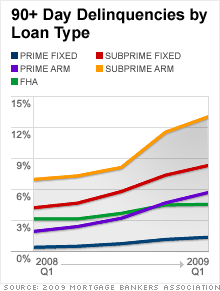Troubled mortgages hit record high
More than 616,000 homeowners were hit with foreclosure actions in the first 3 months of the year, the Mortgage Bankers Association reports.
NEW YORK (CNNMoney.com) -- Despite all the hand-wringing and attempts to contain the foreclosure plague, the problem still spread during the first three months of 2009, as the number of foreclosure actions started hit a record high, according to a quarterly report.
The National Delinquency Survey released Thursday by the Mortgage Bankers Association (MBA), reported the largest quarter-over-quarter increase in foreclosure starts since it began keeping records in 1972. Lenders initiated foreclosures on 1.37% of all first mortgages during the quarter, a 27% increase from the 1.08% rate during the last three months of 2008 and a 36% rise from the first quarter of 2008. All told, more than 616,000 mortgages were hit with foreclosure actions.
Delinquencies, the stage in which borrowers have fallen behind on payments but have not yet received foreclosure notices, also hit record highs, with the seasonally adjusted rate at 9.12% of all loans, up from 7.88% last quarter.
The ugly report was sobering but not unexpected, according to Jay Brinkmann, MBA's chief economist. He pointed out that foreclosure rates had grown little during the previous three quarters, even as the number of homeowners falling behind on mortgage payments continued to soar.
"We suspected that the numbers were artificially low due to various state and local moratoria, the Fannie Mae (FNM, Fortune 500) and Freddie Mac (FRE, Fortune 500) halt on foreclosures, and various company-level moratoria," he said in a prepared statement.
"Now that the guidelines for the administration's loan modification programs are known, combined with the large number of vacant homes with past due mortgages, the pace of foreclosures has stepped up considerably."
And it looks like that pace may continue to increase. There has been a big jump in the number of loans that are 90-days or more overdue, which is a very bad sign since those delinquencies often progress into foreclosure starts. The number of loans 90 days past due rose to 3.39% of all loans, up from 3% a quarter earlier and is more than double the 1.56% level of 12 months ago.
Brinkmann said many seriously delinquent mortgage borrowers have already given up and moved out of their homes, and that these homes constitute a large share of all foreclosures.
"Lenders are not proceeding against any foreclosures they think can be saved," said Brinkmann, "only against vacant properties and others they think have no chance of succeeding."
The nature of these troubled loans is also changing. The mortgage meltdown was ignited back in 2007 by defaulting subprime loans, especially adjustable rate mortgage (ARMs). Now prime loans are the biggest problem.
"The original delinquency and foreclosure problems had a lot to do with loan terms - the toxic mortgages with interest rates that reset higher," said Nicholas Retsinas, the director of Harvard's Joint Center for Housing Studies. "Now we're back to the more traditional reasons why loans go bad. If people don't have jobs, they can't pay their mortgages."
Subprime mortgages were usually issued to the least credit-worthy borrowers and potential payment problems had been offset for years by the hot housing market.
Double-digit home-price increases had enabled cash-strapped borrowers to pay their bills by tapping their added home equity, through cash-out refinancings or home equity loans. Once home prices began to fall, those options evaporated and subprime mortgages began to default at higher rates. The delinquency rate for subprime ARMs reached nearly 28% during the first quarter.
Over the past 12 months, however, as the turmoil in the overall economy increased and job losses mounted, the percentage of foreclosure starts for prime, fixed-rate loans, which account for the majority of all mortgages, have more than doubled, to 0.61% from 0.29%.
"For the first time since the rapid growth of subprime lending, prime fixed-rate loans now represent the largest share of new foreclosures," said Brinkmann.
"I don't see how it can't get uglier," said Dean Baker of the Center for Economic and Policy Research. "Unemployment will continue to go up and you'll have a lot of people out of work, prime workers in their 40s and 50s, who will exhaust their resources."
They'll have no shot at saving their homes unless they can get new work.
Regionally, the biggest contributors to the record foreclosure rates are the so-called "sand states," California, Florida, Arizona and Nevada. These four, which represent less than 18% of the nation's population, account for 46% of foreclosure starts. More than 10% of all mortgages in Florida are in foreclosure.
Those states had much higher rates of subprime lending than average. California, for example, which accounts for 13% of U.S. mortgages, had 18% of all subprime ARMs outstanding during the first quarter. These states also endured severe home price declines, forcing more homeowners into delinquency.
The fact that delinquencies and foreclosures continue to rise is terrible news for the overall economy, according to Pat Newport, a real estate analyst for IHS Global Insight.
"Just about every number in the report is a record high," he said. "It indicates that the problems with the banks will continue for a long time."
Brinkmann displayed little optimism for the immediate future, saying the level of mortgage defaults will not begin to fall until after the employment situation improves.
"MBA's forecast, a view now shared by the Federal Reserve and others, is that the unemployment rate will not hit its peak until mid-2010," he said. "Since changes in mortgage performance lag changes in the level of employment, it is unlikely we will see much of an improvement until after that." ![]()


